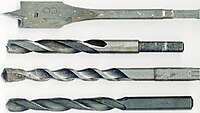
Photo from wikipedia
Abstract Carbon fibre reinforced plastics (CFRP) and Al5052 sheets were joined by coaxial one-side resistance spot welding (COS-RSW). The cross-section features and mechanical behaviour of the joints in single lap… Click to show full abstract
Abstract Carbon fibre reinforced plastics (CFRP) and Al5052 sheets were joined by coaxial one-side resistance spot welding (COS-RSW). The cross-section features and mechanical behaviour of the joints in single lap shear (SLS) test were investigated. The underlying joining mechanism was found to be the N C O covalent bond between silane coupling agent and CFRP via the X-ray photoelectron spectroscopy (XPS) analysis. The joints of low welding current exhibited interfacial fracture with low strength and small displacement during the SLS test, while the joints of high welding current presented a staged failure process with tearing of the CFRP, which gave higher strength and larger displacement. The bonding zone was divided into three subzones, which showed specific surface morphologies and distinct contributions to the load-bearing capacity of the joint. The joining strength showed a positive correlation with welding current until the occurrence of decomposition in CFRP, which reduced the area of effective bonding zone and played a negative effect on strength.
Journal Title: Composite Structures
Year Published: 2020
Link to full text (if available)
Share on Social Media: Sign Up to like & get
recommendations!